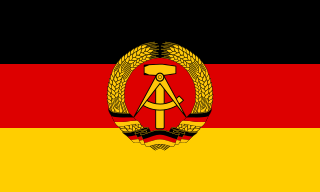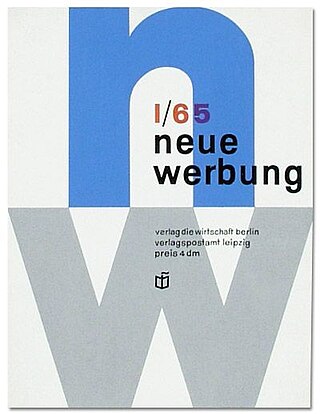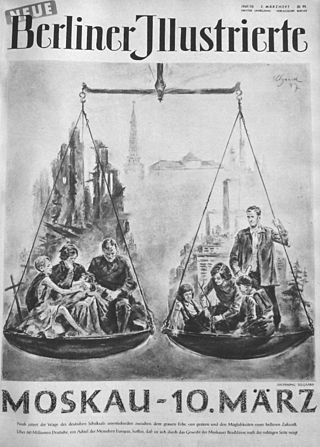Related Research Articles

East Germany, officially the German Democratic Republic, was a country in Central Europe that existed from its creation on 7 October 1949 until its dissolution on 3 October 1990. Until 1989, it was generally viewed as a communist state, and it described itself as a socialist "workers' and peasants' state". Before its establishment, the country's territory was administered and occupied by Soviet forces with the autonomy of the native communists following the Berlin Declaration abolishing German sovereignty in World War II; when the Potsdam Agreement established the Soviet-occupied zone, bounded on the east by the Oder–Neisse line. The GDR was dominated by the Socialist Unity Party of Germany (SED), a communist party from 1949 to 1989, before being democratized and liberalized under the impact of the Revolutions of 1989 against the communist states, helping East Germany be united with the West. Unlike West Germany, SED did not see its state as the successor of the German Reich (1871–1945) and abolished the goal of unification in the constitution (1974). Under the SED rule, GDR was often judged as a Soviet satellite state; most scholars and academics described it as a totalitarian regime.

German reunification was the process of re-establishing Germany as a single full sovereign state, which took place between 9 November 1989 and 15 March 1991. The day of 3 October 1990 when the "Unification Treaty" entered into force dissolving the German Democratic Republic and integrating its recently re-established constituent federated states into the Federal Republic of Germany to form present-day Germany, has been chosen as the customary German Unity Day and has thereafter been celebrated each year as a national holiday in Germany since 1991. As part of the reunification, East and West Berlin of the two countries were also de facto united into a single city; which later eventually became the capital of this country.

The term "Soviet empire" collectively refers to the world's territories that the Soviet Union dominated politically, economically, and militarily. This phenomenon, particularly in the context of the Cold War, is also called Soviet imperialism by Sovietologists to describe the extent of the Soviet Union's hegemony over the Second World.

Stern is an illustrated, broadly left-liberal, weekly current affairs magazine published in Hamburg, Germany, by Gruner + Jahr, a subsidiary of Bertelsmann. Under the editorship (1948–1980) of its founder Henri Nannen, it attained a circulation of between 1.5 and 1.8 million, the largest in Europe's for a magazine of its kind.
The Congress for Cultural Freedom (CCF) was an anti-communist propaganda group founded on June 26, 1950 in West Berlin, and was supported by the Central Intelligence Agency and its allies. At its height, the CCF was active in thirty-five countries. In 1966 it was revealed that the CIA was instrumental in the establishment and funding of the group. The congress aimed to enlist intellectuals and opinion makers in a war of ideas against communism.

Melvin Jonah Lasky was an American journalist, intellectual, and member of the anti-Communist left. He founded the German journal Der Monat in 1948 and, from 1958 to 1991, edited Encounter, one of many journals revealed to have been secretly funded by the CIA through the Congress for Cultural Freedom (CCF).

The German Democratic Republic (GDR), German: Deutsche Demokratische Republik (DDR), often known in English as East Germany, existed from 1949 to 1990. It covered the area of the present-day German states of Mecklenburg-Vorpommern, Brandenburg, Berlin, Sachsen, Sachsen-Anhalt, and Thüringen. This area was occupied by the Soviet Union at the end of World War II excluding the former eastern lands annexed by Poland and the Soviet Union, with the remaining German territory to the west occupied by the British, American, and French armies. Following the economic and political unification of the three western occupation zones under a single administration and the establishment of the Federal Republic of Germany in May 1949, the German Democratic Republic was founded on 7 October 1949 as a sovereign nation.

After the end of World War II Germany was separated into nation-states. Each nation-state was governed by a different country because officials could not agree on peace terms. The Soviet Union had claimed the eastern portion of the country. In 1947, the "German People's Congress for Unity and Just Peace" met in Berlin. The Congress was to take the demands of all the occupied zones, and create a peace treaty which would enact a centralized German government. In order to have their nation-state properly represented, the Soviets created the German Democratic Republic in 1949 when they officially approved their constitution in May.
FORVM was an Austrian monthly cultural and political magazine, published in Vienna from 1954 to 1995, founded by Friedrich Hansen-Loeve, Felix Hubalek, Alexander Lernet-Holenia and Friedrich Torberg with the financial and logistical support of the CIA-funded Congress for Cultural Freedom (CCF). Torberg also edited the magazine from its start in 1954 to 1965. In 1965 Günther Nenning took over as editor and in 1986 Gerhard Oberschlick.
A communist front is a political organization identified as a front organization under the effective control of a communist party, the Communist International or other communist organizations. They attracted politicized individuals who were not party members but who often followed the party line and were called fellow travellers.
The anti-Stalinist left is a term that refers to various kinds of Marxist political movements that oppose Joseph Stalin, Stalinism, Neo-Stalinism and the system of governance that Stalin implemented as leader of the Soviet Union between 1924 and 1953. This term also refers to the high ranking political figures and governmental programs that opposed Joseph Stalin and his form of communism, such as Leon Trotsky and other traditional Marxists within the Left Opposition.

Kultur im Heim was an East German women's magazine specializing on home decoration and home design. The magazine was published between 1956 and 1989.

Neue Werbung was an East German trade magazine specializing on advertising. Originally subtitled Fachzeitschrift für Werbung, Gebrauchsgrafik und Dekoration, the magazine was published between 1954 and 1991. Its headquarters was in East Berlin.
Sibylle was a bimonthly fashion magazine that was published in East Germany and then in Germany from 1956 to 1995. The magazine was subtitled Zeitschrift für Mode und Kultur. It is known as the most famous fashion magazine of East Germany and was called Vogue of East Germany.
Bruno Flierl was a German architect, architecture critic, and writer. His work focused on architecture, urban development, and city planning of East Germany. He assisted in the design of the Pariser Platz and argued for the preservation of the Palace of the Republic in the debate over the restoration of the Berlin Palace.

Sinn und Form is a bimonthly literary and culture magazine. It was launched in East Berlin, East Germany, in 1949 and is still in circulation. The magazine describes itself as one of the definitive cultural journals in Germany.
Für Dich was a weekly women's magazine published in East Germany and then in Germany following the unification. It was the only publication in East Germany which specifically targeted women. Official description of the magazine in 1988 was "illustrated weekly magazine for women, with contemporary political, economic and cultural contributions." It was in circulation between 1946 and 1991.

Neue Berliner Illustrierte was a weekly illustrated magazine which existed between 1945 and 1991. It was published in East Germany and then in Germany following the German reunification. Its title was a reference to Berliner Illustrirte Zeitung which was an influential German publication at the beginning of the 20th century.
Neues Leben was a monthly youth magazine which existed between 1953 and 1992. It was started in East Germany and survived the German unification. It was briefly published in Germany until 1992.
Heinz Hirdina was an East German design theorist and editor.
References
- 1 2 Michèle-Anne Dauppe (Winter 1991). "After the wall". Eye .
- 1 2 3 Natalie Scholz; Milena Veenis (2012). "Cold war modernism and post-war German Homes: An East-West comparison". In Peter Romijn; Giles Scott-Smith; Joes Segal (eds.). Divided Dreamworlds?: The Cultural Cold War in East and West. Amsterdam: Amsterdam University Press. p. 166. ISBN 978-90-8964-436-7.
- 1 2 3 Karin Zachmann (January 2002). "A Socialist Consumption Junction: Debating the Mechanization of Housework in East Germany, 1956-1957". Technology and Culture . 43 (1): 73–99. doi:10.1353/tech.2002.0047. JSTOR 25147855. S2CID 153602189.
- 1 2 3 Paul Betts (2000). "The Twilight of the Idols: East German Memory and Material Culture". The Journal of Modern History . 72 (3): 758. doi:10.1086/316046. S2CID 144800205.
- ↑ Aniruddha Gupte (2019). "Synthesizing Solutions: An Exploration of the Modern Relevance of Socialist Design Principles through the Medium of Plastics". Popular Inquiry. 1. ISSN 2489-6748.
- ↑ Andreas Ong; et al. (January 2000). "Meetingplace: Kulturbrauerei" (PDF). Kulturverkstan.
- 1 2 Florian Urban (July 2007). "Designing the past in East Berlin before and after the German reunification". Progress in Planning. 68 (1): 34. doi:10.1016/j.progress.2007.07.001.
- ↑ Jana Scholze (2011). "Shifting Narratives of Things: The East/West German Garden Egg Chair". Socialist Architecture. ISSN 1048-9134.
- ↑ "Art Calendar". Goethe-Institut . June 2014. Archived from the original on 30 May 2015. Retrieved 30 May 2015.
- ↑ "Gesamtinhaltsverzeichnis" (PDF). Form und Zweck Archive. Archived from the original (PDF) on 6 March 2016. Retrieved 15 September 2016.